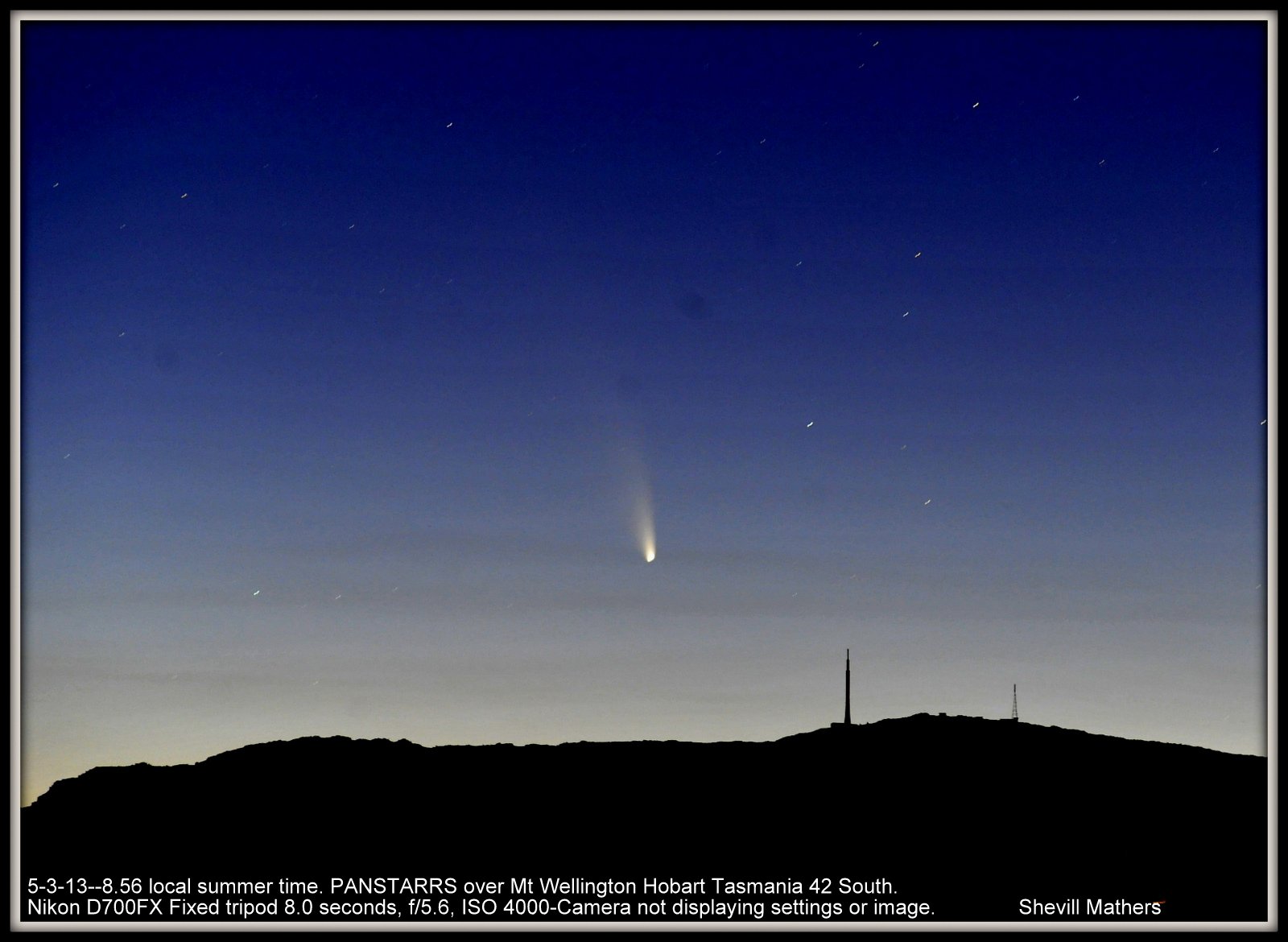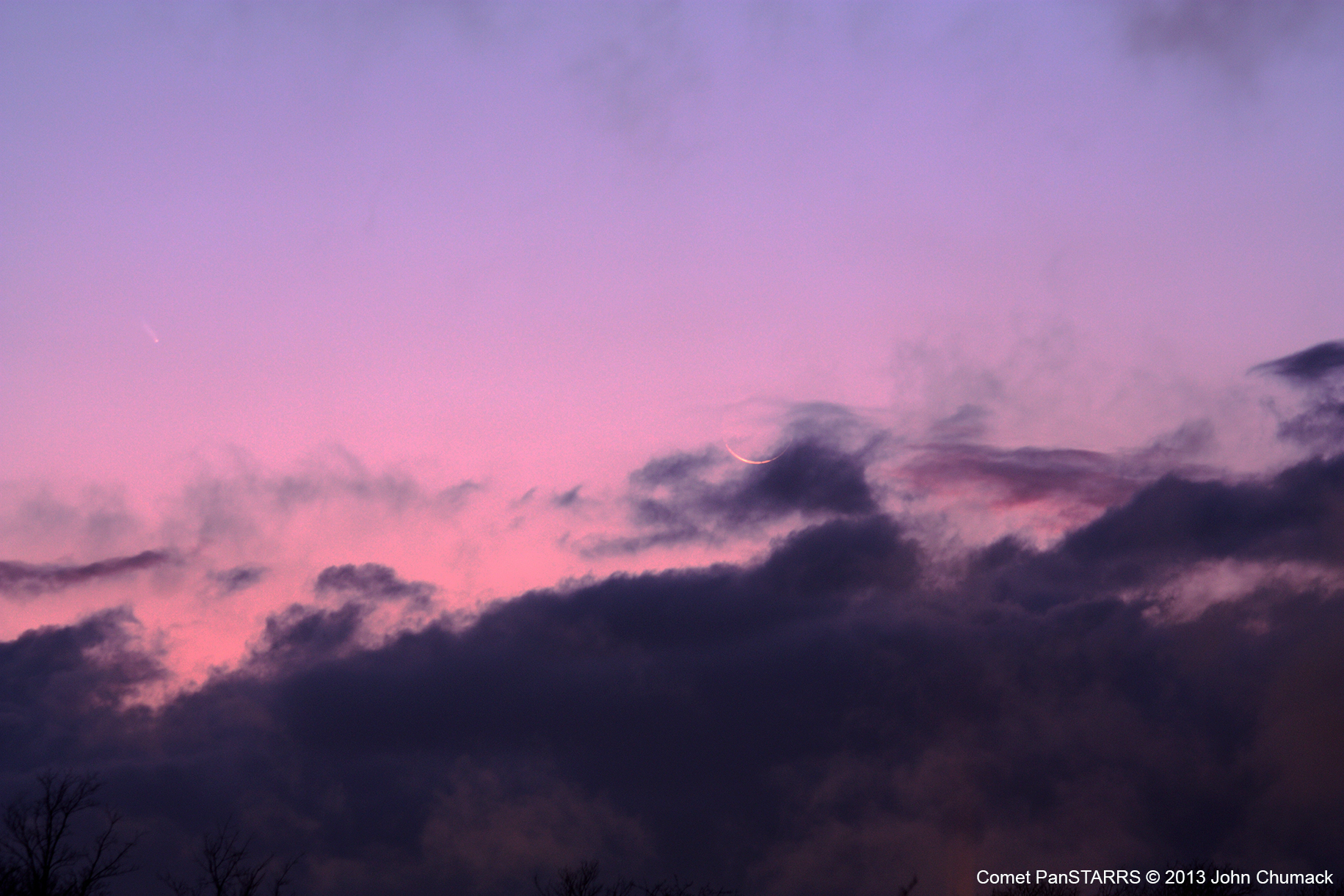
Now having passed the Sun, Comet C/2011 L4 PANSTARRS ended its reign of the Southern Hemisphere skies and is now breaking the western horizon and is visible for Northern Hemisphere observers. So far the bright comet has made an awesome impression on those who have had a chance to both view and photograph it. Let's begin at the ending — and check out a report from Tasmania.

Comet PANSTARRS Courtesy of Shevill Mathers March 5, 2013
"I have observed/photographed Comet PANSTARRS on two successive nights just after sunset and with the comet about 10 degrees about the horizon." reports renowned astrophotographer, Shevill Mathers of Southern Cross Observatory. "I observed it naked eye, easily visible, and with 10x50 binoculars? a superb view. The fan-shaped tail is quite visible and covers perhaps three degrees of sky. The head is very bright and to me appeared to have yellowish hue. However, our skies are filled with varying degrees of bush fire smoke."
As he observed, Mathers was quite taken at how quickly that C/2011 L4 appears to set. Although the comet itself isn't actually moving that quickly, the position so near the horizon seems to be accelerated - an illusion all amateur astronomers well know. Remember to take this low position into consideration during the first few days after PANSTARRS becomes visible to the Northern Hemisphere. It would be very disappointing indeed to find out the comet had "set" before you had a chance to see it!
Now that Comet PANSTARRS has arrived on the northern scene, it's not far away from the setting Sun and it certainly isn't an easy target. Although it is anticipated to be as bright as magnitude 2, the twilight skies will greatly interfere with detailed sightings and the observing window to see the comet is roughly in the 30 minute range. However, don't give up hope! As time quickly passes, Comet PANSTARRS will climb higher each night -moving its way through Pisces, then on through Pegasus and Andromeda. For a very lucky few, the comet made an awesome appearance on the evening of March 12th, when it was just a few scant degrees south of the crescent Moon. Check out this image taken by John Chumack.

Comet PANSTARRS Courtesy of John Chumack March 12, 2013
As luck would have it, Comet L4 PANSTARRS didn't come to John — he had to go to it. His mission was to head west against great odds to catch this comet conjunction. Says Chumak, "Sometimes it's worth traveling to increase your chances of witnessing something astronomical, even if your original plan does not work out, I'm so glad I went to Indy. One should never give up hope... as opportunities can come your way at any time!"
Just how will this icy visitor look in the sky? During the opening of the show, you will most likely need 50mm or larger binoculars to pick it out of the twilight glow, but as it climbs higher it will match the brightness of the major stars of Pegasus and — once located — should be able to be seen without optical aid for a short period of time. As C/2011 L4 PANSTARRS moves northward — and further away from the Sun — it will require a small telescope or larger astronomical binoculars to be spotted. For the most part, the comet will appear as a thin scratch, very much like a tiny contrail and be roughly about half the length of your little fingernail when held at arm's length. It is not going to jump out and wave a sign. (But then, perhaps it will!) Look for this "scratch" on the sky no more than about a handspan above the northwestern horizon. Once you initially spot it, it will be much easier to locate on successive nights as it climbs slightly higher and moves more slightly more northward.
Don't be "underwhelmed" and by no means be discouraged if your views of PANSTARRS are mediocre. Even though this particular comet isn't a huge affair that dominates the night sky, it is still a rare occurrence and should be treated as such. For those of us who have routinely observed comets, they are normally very small, dim, fuzzy contrast changes... and PANSTARRS is a rare treat!
As you follow the Comet PANSTARRS, be sure to watch for changes. How does the nucleus appear from night to night? How bright is the coma? Does the comet have a duo tail? How far does the tail extend? Be sure to take a few moments to sketch the comet for your records and follow the "How To Log Your Comet Observations" instructions for getting the most out of your time. You'll be glad you did!

















